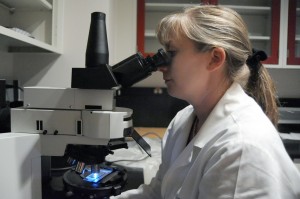Trace Evidence
 The Trace Evidence Section examines fire debris, explosives, paint, hairs, fibers, glass, primer residue (PR), fracture matches, and vehicle lamps. In addition, the section analyzes a variety of unknown substances for identification or comparison.
The Trace Evidence Section examines fire debris, explosives, paint, hairs, fibers, glass, primer residue (PR), fracture matches, and vehicle lamps. In addition, the section analyzes a variety of unknown substances for identification or comparison.
Specifically, we examine:
- Fire Debris: Extractions are performed and identifications are made using the gas chromatograph/mass spectrometer (GC/MS). Analysis is typically for the presence or absence of ignitable liquids.
- Explosives: Analysis for explosives or explosives residues may include commercial, military or improvised explosive devices. To the extent possible, a determination of construction, ignition/detonation source, origin of materials and the function of the device is made. A variety of procedures and instrumentation may be used.
- Paint: Paint, polymers and other coatings are analyzed to ascertain probable origin. The most common types of paint submitted to the laboratory are vehicular and structural. A hit and run situation would be an example of vehicular paint; and a tool being used to pry open a door would be an example of structural paint. The microscopic examination for color, texture and layer structure is extremely important. Instrumental analysis is performed to determine the organic and inorganic composition of the materials.
- Hairs: Hairs are assessed microscopically to determine whether they originated from a human or an animal. Human hairs are then evaluated to determine their suitability for nuclear DNA testing.
- Fibers: Fabrics, carpets, and ropes are common types of evidence submitted for fiber identifications and/or comparisons. Examinations of known and questioned fibers start with microscopic comparisons where they are viewed side-by-side on a comparison microscope. Further examinations may include microchemical/microsolubility testing, color comparisons via microspectrophotometry (MSP), fiber cross-section determinations, and chemical composition comparisons via infrared spectrophotometry (FTIR).
- Glass: Glass analysis usually involves the comparison of the physical and/or optical properties of known and questioned glass sources. The refractive index (R.I.) of the glass sources is determined using the Glass Refractive Index Measurement system (GRIM3). If enough glass is present to reconstruct a pane, the direction of the impact or sequence of impacts may be determined.
- Primer Residue: Primer Residue (PR) can be deposited on the hands by circumstances such as: firing a weapon, handling a weapon, being in the proximity to the discharge of a weapon or coming into contact with an object that has primer residue on it. PR analysis is performed on evidence from PR collection kits developed and provided by the Department of Forensic Science. These kits employ sticky tape on a thumbtack-like “stub” that is used to sample the hands of an individual suspected of firing a weapon. Examiners use an automated scanning electron microscope/energy dispersive x-ray system (SEM/EDS) to confirm the morphology and elemental composition of any particles found.
- General Chemical Analysis: General Chemical (GC) analysis involves the physical and/or chemical analysis of unknown materials (non-biological in nature) for identification or comparison purposes. There are numerous types of evidence which fall into this category. Some of the more common examples include: pepper spray or mace, bank security dye packs, adhesive tapes, acids/bases, and unknown liquids and powders. The analytical scheme will depend on the type of material present.
- Vehicle Lamps: The primary purpose of a vehicle lamp examination is to determine whether the lamp was “on” or “off” when the vehicle was subjected to impact shock. Often, this question can be answered by examining the filament of an incandescent vehicle lamp. The stresses generated on a filament by the accelerations and sudden stops of a collision produce deformation and fracture phenomena with characteristic differences between hot and cold filaments. Additionally, if the vehicle lamp housing is broken during impact, it may be possible to physically fit pieces left at the scene to the headlamp housing from a suspect vehicle.
